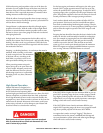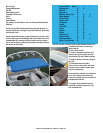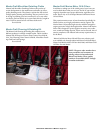
Failure to follow these instructions in the proper care of up-
holstery may cause your warranty to be voided!
e cleaning table presented in this section is oered only as a
suggestion and as an aid in attempting to deal with stains. We do
not guarantee that the cleaning methods will work. Stains from
any external source are unlikely to be covered by warranty.
Carpet
Occasionally washing with mild detergent and warm water
or household carpet cleaners will help keep the carpet clean.
oroughly hose the detergent out of the carpet and into the
bilge. (is is a good time to clean the bilge also.) Allow the boat
to remain uncovered to air dry for several days to prevent any
mildew or odor caused by moisture.
Teak Wood
Regular cleaning and oiling of teak wood will maintain its origi-
nal appearance. Use a teak cleaner that can penetrate the pores
of the wood and cleanse them of dirt and stains. Avoid caustic
teak cleaners since they can damage the wood. Immediately aer
cleaning, an oil sealer should be applied with a so cloth. (Fol-
low the directions for application and maintenance that appear
on the cleaner and sealer can or bottle.)
Fiberglass Swim Platform
e berglass swim platform requires the same kind of regu-
lar—and gentle—cleaning that the rest of the boat needs. Aer
cleaning o any environmental debris, wash with mild soap and
warm water. Avoid the use of ArmorAll or similar types of rub-
ber-shine products as these will speed the decay of the rubber
rather than protecting it.
Windshield
In cleaning tempered glass windshields, the normal glass
cleaners (from spray bottles or aerosol cans) work best. While
the glass is very strong, it can be scratched if anything abrasive
is used. Harsh chemicals or solvents should be avoided because
they may aect the vinyl gaskets or powder-coated nish on
the extrusions.
More care should be taken when cleaning the clear Eisenglass
curtains, which are an option on some boat models. Eisenglass
curtains are usually made with clear vinyl sheeting, which is
much soer and more prone to scratching and hazing than the
windshield glass is, only so cloths and mild detergents should
be used.
Canvas Covers
e material used in constructing Bimini tops and boat covers
is made from 100 percent solution-dyed polyester ber with
a urethane coating to provide excellent water repellency and
mildew resistance. is design allows the material to be easily
maintained. By following a few simple care and cleaning steps,
the fabric will continue to look good and maintain its ne quali-
ties for seasons to come.
Important Background Information
Because the fabrics are woven, they are breathable. It’s also im-
portant to know that these fabrics are treated with a uorocar-
bon nish, which enhances water repellency. is nish requires
replenishment aer vigorous cleaning.
Polyester fabric will not support the
growth of mildew. Mold and mildew
need something on which to grow and
polyester fabric is not a desirable sub-
stance for such growth. Dirt or dust on
the fabric, however, is a perfect source
for mildew growth, which makes regular
cleaning of the fabric important.
ere is no set time for when the fabric
should be cleaned, and the local environ-
ment has a great deal to do with deter-
mining cleaning frequency. Cleaning is
required less frequently in a dry environ-
ment than in a humid one where heavy
foliage exists.
e material has an applied nish
that deters mold and mildew growth, but it does not make it
mold-proof. Keeping the fabric free of dirt and foreign sub-
stances is important in deterring mold growth.
Cleaning
One of the best ways to keep the material looking fresh and new,
and to delay the need for deep or vigorous cleaning, is to hose
o fabrics with clear water on at least a monthly basis with clean
water. is practice will help prevent dirt from becoming deeply
embedded in the fabric, and it will eliminate the need for more
frequent and more vigorous cleanings.
MasterCraft 2009 Owner’s Manual - Page 13-2


















